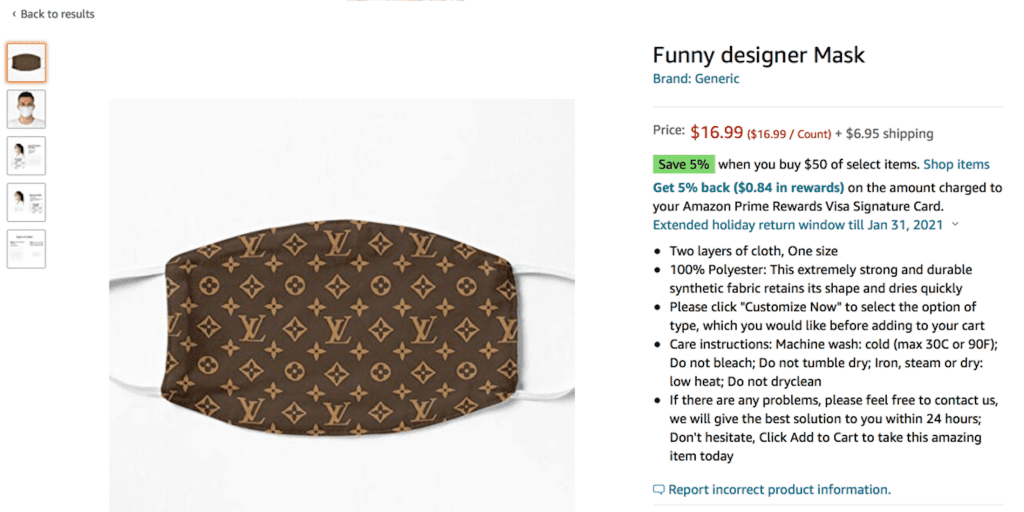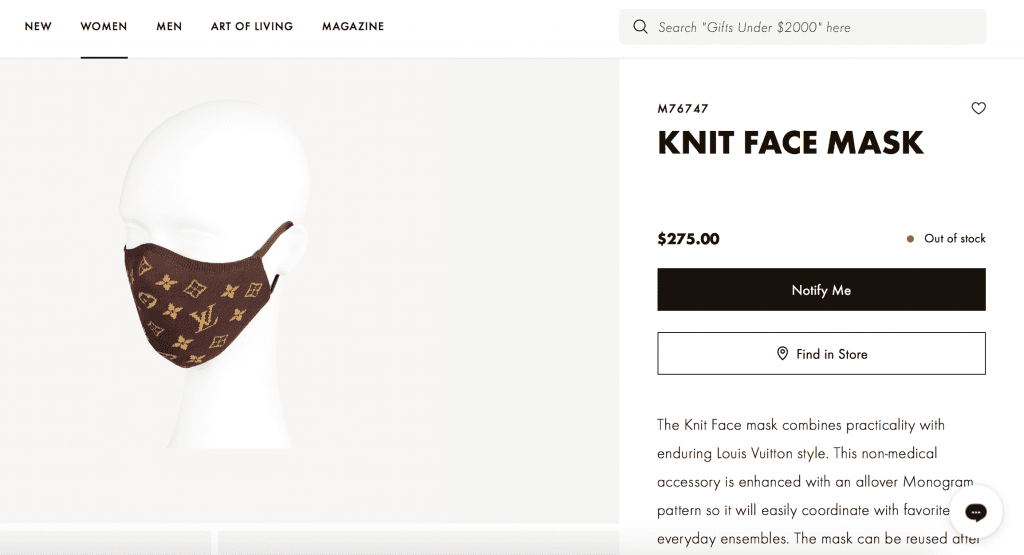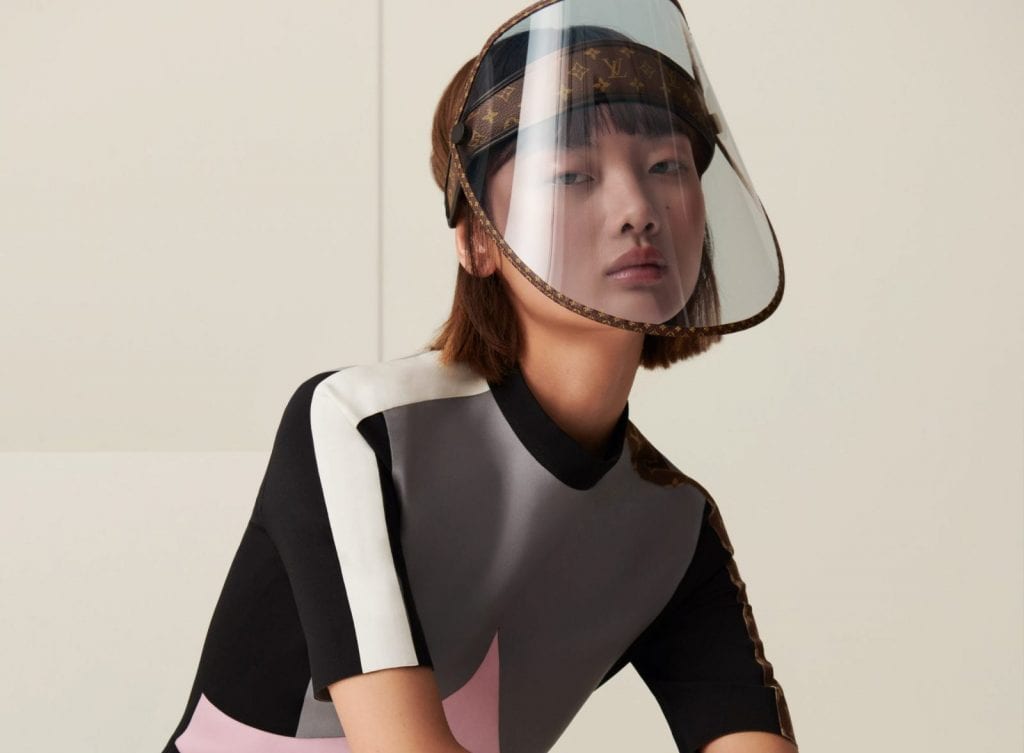The U.S. market for face masks is positively booming. Projected to reach $6 billion in 2021, according to investment bank KeyBanc Capital Markets, companies are placing their bets on demand for not only utilitarian face coverings but decorative, and even luxury-level ones, as the item of COVID-centric protective gear has swiftly evolved into a fashion ornament – albeit a mandatory one in most jurisdictions – and created a new category of accessory in the process, one that is being compared to the likes of “it” bags and the latest trend in coveted sneakers.
Since the outset of the global health pandemic, the notion of logo-laden, designer face masks has become increasingly less taboo, and as the practical need to wear a mask endures, the attitude of many consumers has shifted. The result? A new emphasis on the fashion aspects of these necessary accessories in addition to the purely functional ones. “Face coverings might be a matter of practicality in the era of COVID-19,” the Los Angeles Times’ Lindzi Scharf wrote in September. “But for the 1 percent, fancy masks and shields have become a new opportunity to project individual status.”
“This kind of evolution is natural. It may be inevitable. It is the kind of human impulse fashion is built to serve,” the New York Times’ Vanessa Friedman asserted in April.
Against that background and in light of a drastic drop in sales of many of their other offerings, fashion brands – from burgeoning young upstarts to established names in the high fashion arena – have clamored to enter the face mask market to meet mounting consumer demand.
And the demand is there. Etsy reported selling 24 million face masks in the September quarter, the Wall Street Journal recently reported. Meanwhile, data from Lyst shows that over the past three months, searches for designer face masks have surged by 33 percent. Lyst’s figures put Fendi’s FF logo pollution mask (currently sold out) at the top of the list of “the most wanted luxury-brand face masks,” with a representative for the fashion discovery platform telling TFL that between September and November, the $270 silk mask, with its “signature logo motif,” was generating over 1,000 daily searches.
Outside of “high fashion category,” Lyst says that buzzy streetwear/fashion brand Off-White’s $105 diagonal face mask has been “the top-most wanted mask.” And elsewhere in the market, Louis Vuitton made headlines in September when it introduced a Toile monogram-trimmed face shield. The world’s largest luxury goods brand described the COVID-centric accessory as designed to be “both stylish and protective.” The reported cost of the Louis Vuitton shield? Upwards of $1,000.

Not all masks come with a price tag as steep as Louis Vuitton’s face shield, and in fact, certain high-end fashion brands have adopted something of a different strategy, and are using face masks as a “new customer acquisition tool,” Adam Bluestein wrote for Marker in September. The likes of Burberry, which was one of the first luxury brands to launch a specific face mask collection this summer, Marni, and Dolce & Gabbana, among others, are essentially using masks in the same way that luxury brands have long-used more accessible, high margin-producing items, such as fragrances and eyewear, as “lower-priced entry-level items to attract people to the brand.”
As luxury brands rush to establish face masks as a distinct – revenue-driving – category of accessories, the race to file mask-specific trademark applications has already begun, with applications being lodged with national trademark offices across the globe as early as July, just a month after the World Health Organization published its guidelines suggesting laypeople wear fabric masks and leave the medical-grade masks to the frontline professionals who need them most. (Interestingly, most luxury brands do not already maintain registrations that extend to protective face masks or coverings).
Kering-owned company Yves Saint Laurent, for instance, filed two trademark applications with the U.S. Patent and Trademark Office (“USPTO”) for the goods/services in classes 9 and 10, for various types of “protective” and “respiratory masks.” The marks at play? A stylized version of its “Saint Laurent Paris” mark, as well as “Yves Saint Laurent” in the brand’s original (pre-Hedi Slimane) font. That same month, Burberry filed a U.S. application for the use of its name on “masks for medical use; sanitary masks for medical purposes; disposable sanitary masks; sanitary masks made of cloth; face protection shields for medical purposes.”
More recently, in November, Louis Vuitton – whose various logos are regularly being slapped on masks and sold on digital marketplace sites – has filed a handful of applications for registration with the USPTO, seeking to register its name, interlocking “LV” logo, Damier Azur pattern, and Toile Monogram print for use on “protective face shields; protective masks; protective chin shields; [and] protective gloves” (class 9), and “face masks for medical use; Surgical masks; protective face shields for medical use; protective chin shields for medical use; [and] gloves for medical use” (class 10).

Brands’ attempts to add mask-centric registrations to their larger trademark arsenals are not limited to the U.S., of course. At the same time that Burberry filed its application with the USPTO, it filed applications in Australia, Singapore, and Spain for its use of its marks on masks. And not to be outdone on the trademark front, notoriously-aggressive-filer Off-White has been busy filing trademark applications that specifically extend to masks – and in some cases, hand sanitizers – in Mexico, Malaysia, and Singapore over the past few months.
As for the impetus behind brands’ quests for registrations, the aim appears to be two-fold. Not only are companies looking to protect the use of their valuable brand names, logos, and in some cases, monogram prints, in connection with their use on face masks and other coverings, they are also presumably looking to up the ante when it comes to damages. With a trademark registration that covers masks in hand, brands will be able to not only bring trademark infringement cases of action, but counterfeiting claims, as well.
The latter is particularly relevant, as a plethora of fake designer face masks in all the shapes, fabrics, and logos imaginable have inundated sites like Amazon and Etsy, and physical counterfeit havens like Canal Street in New York. All the while, U.S. Customs and Border Control officials have been intercepting incoming shipments of counterfeit trademark-bearing masks. In June, Customs revealed that it has seized more than 2,000 masks emblazoned with unauthorized designer logos – from Supreme to Chanel – at ports in New Orleans and Shreveport, Louisiana.
Unsurprisingly, as luxury masks continue to gain steam, even amid talks of vaccines, and thereby, further cement themselves and their new-found “it” status, many of the key concerns that routinely come with brands’ most in-demand offerings – namely, a rise in counterfeits – are in play here. Chances are, there are many more trademark filings in the works.
*Ellie Sanders holds an M. Sc. from the London School of Economics, and is currently a J.D. candidate at New York Law School.











